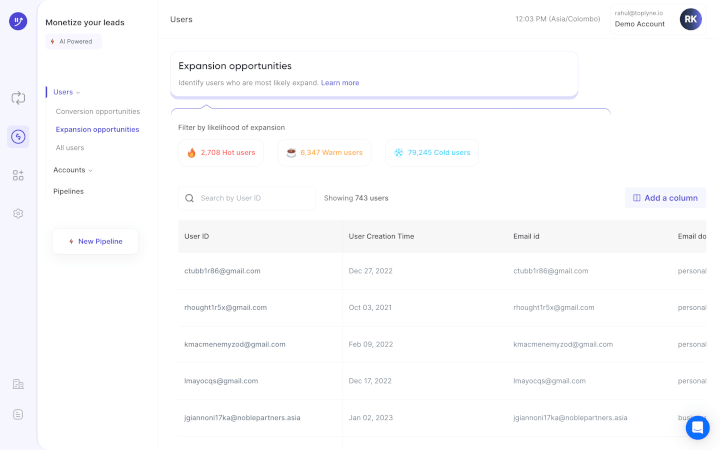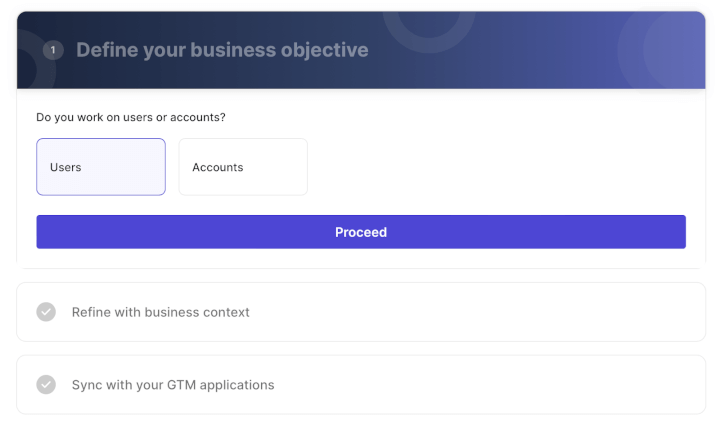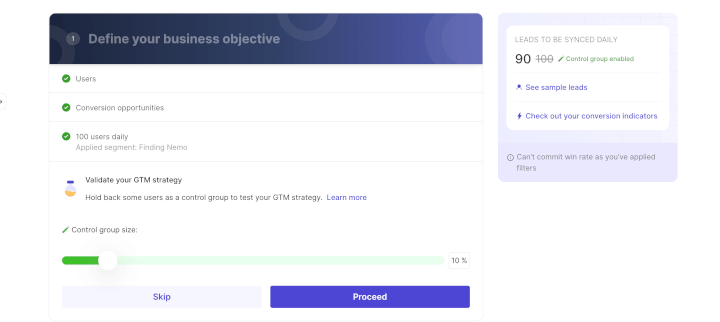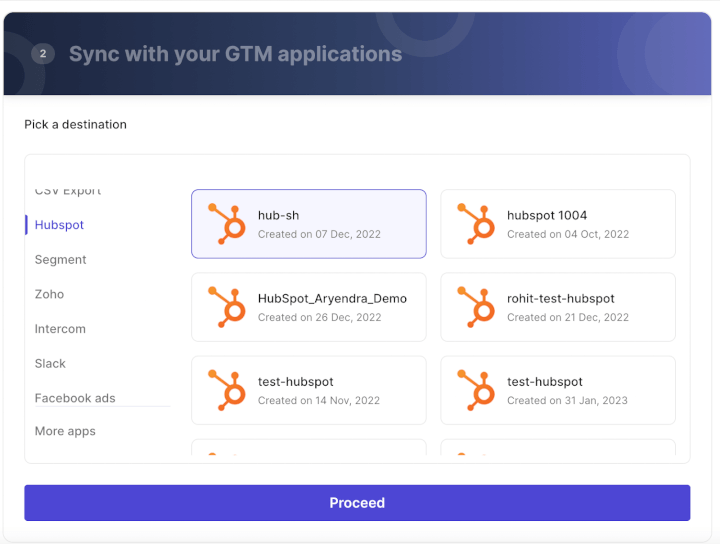Lead Scoring Predictive Analytics: The Secret to SaaS Success

If you're tired of wasting your sales team's precious time chasing dead-end leads, this is for you.
With predictive lead scoring analytics, you can replace the guesswork of lead qualification with data-driven insights.
In this article, we'll explore predictive lead scoring, its benefits, how to develop a predictive model, and how to know if it works.
We'll also discuss whether lead scoring predictive analytics are right for you — particularly if you’re into product-led growth. Lastly, we’ll introduce a tool that melds predictive analytics and PLG.
Let’s get started.
What Is Predictive Lead Scoring?
Firstly, lead scoring is a key marketing automation process that involves assigning points to leads based on their interactions with your marketing, website, and product. The lead score helps you determine how close they are to converting.
Here’s how the pipeline from potential lead to customer works:
- A new prospect enters the funnel as a marketing qualified lead (MQL). You’ll use various lead nurturing tactics to encourage MQLs to advance in the pipeline.
- Through lead scoring, you can track their progress to conversion. Each time they interact with your website, marketing, or product, they earn points representing their conversion potential.
- A potential customer that’s ready to buy is called a sales qualified lead (SQL). Companies typically send sales reps to communicate with each potential customer one-on-one and attempt to make a sale.
Note: You may want to focus on product qualified leads (PQLs), which is difficult for most lead scoring tools. We’ll cover this later and provide a tool that can help.
There are two main ways to do lead scoring – the traditional way and the predictive way.
With traditional lead scoring, you choose the actions you want to score and decide how to allocate points.
For example, you can tell the lead scoring solution to assign 20 points when a lead visits your pricing page or 10 points when they open an email.

You can set this up manually or using lead scoring software.
The traditional lead scoring model can be time-consuming and less scalable.
Enter predictive lead scoring.
Predictive lead scoring tools use machine learning and artificial intelligence to construct and maintain a scoring system for your product.
A machine learning model might qualify leads and predict lead conversion in a few different ways, including logistic regression, decision trees, or neural networks. Logistic regression and decision tree models are more popular, with the former being generally more accurate.
But don’t worry – You don’t need to understand the intricacies of the machine learning model to assess if it works.
Basically, predictive modeling uses historical and new data to learn what potential lead behaviors to look for and how to score them.
Using technology to make our work easier – sounds great, right?
Let’s look at the benefits of predictive analytics over traditional systems.
Five Key Benefits of Predictive Lead Scoring
Here are five ways predictive lead scoring can improve the way you do business:
1. Align Sales and Marketing Efforts
What happens when your conversion rate is low? The marketing team blames the sales team for not closing, and sales blames marketing for poor lead generation.

Predictive lead scoring tools quickly process each data point to identify the best leads.
This is great for your sales team because it means they’re getting quality leads with a high likelihood of converting.
Moreover, a predictive lead scoring solution can analyze conversions as they happen. This informs the marketing team on which leads to target and how.
It helps to get both teams on the same page while automating much of the work involved.
2. Boost Efficiency and Accuracy of Lead Qualification
There’s no denying that a computer can handle data far more quickly than any human. 🤖💪

With traditional lead scoring, you’ll work hard to establish and maintain your scoring system.
Predictive lead scoring can provide results much faster with less upfront effort.
Additionally, it solves the problem of human error and leans heavily on data-driven insights.
3. Improves the Customer Experience
No one likes to be contacted by a sales rep when they aren’t interested in purchasing.

In marketing, you want to show relevant content to the right leads.
Predictive lead scoring helps you understand what kind of marketing campaign, channel, or content produces the best leads.
And if leads find your outreach more engaging, it’s better for customer satisfaction.
4. Helps you Outperform Competitors
According to this 2023 study, companies that implement predictive lead scoring see amazing results like:
📈 10% improvement in conversion rate compared to traditional lead scoring models.
💸 15% increase in profit
😀 36% increase in customer satisfaction
⬆️ 70% increase in lead generation ROI (return on investment)
😱 300% increase in per-customer spending amount
Despite the benefits, most businesses don’t use lead scoring at all.
If you get in on predictive scoring now, you could gain a significant head start on your competitors.
5. It Keeps Getting Better
Machine learning models can seem quite mysterious.
But the important thing to know about a predictive model is that it continuously trains itself on newly available sales data. The machine learning algorithm improves itself as you get more conversions and lead data.
This is not true for the traditional lead scoring model, where you must manually make any necessary improvements to the scoring system.
You may be thinking, “Sounds good! But how do I implement a predictive lead scoring system?”
Let’s find out.
How to Develop a Lead Scoring Predictive Analytics Model
Establishing a predictive lead scoring model may seem daunting, but it can be broken down into three simple steps:
Step 1: Deciding on Your Data
It’s true that predictive modeling does a lot of the work for you. But you still need to provide the customer data and point it in the right direction.

Firstly, you must decide on an optimization goal.
Are you trying to get more conversions, boost retention, or increase revenue per customer?
You’ll also need a customer analytics tool (like Google Analytics or Hubspot) to collect relevant data and share it with the predictive analytics tool.
Step 2: Choosing a Software
There are many predictive lead scoring tools available, and that can make it hard to choose. It can take a lot of research and a bit of (free) trial and error.
A good predictive analytics tool should be:
- Able to integrate with your existing customer relationship management (CRM) software.
- Intuitive and easy for you and your team to understand.
- Customizable in terms of scoring criteria and weighting.
- Offering plenty of self-service support resources and a reliable (human🧍) customer support team.
- Able to produce accurate results.
- Affordable according to your budget and needs.
Step 3: Understanding Your Attributes
The machine learning algorithm will work immediately, provided you have enough data. But it may help to understand what kinds of sales data it considers.
There are two main data types in a lead scoring process – Implicit and explicit data.

No, not that kind of explicit.
Explicit data is information you know about a prospect, usually because they told you in a form or during the sign-up process. This can include their:
- Name or business’s name
- Geographical location
- Business size
- Role at the company
- Email address
The predictive lead scoring software uses this information to assess whether a lead is a good fit for your SaaS product based on your ideal customer profiles (ICPs). So, you’ll have to ask customers the right questions.
Implicit data is information gathered from prospects’ actions, such as:
- Pages visited
- Time spent on pages
- Number of website visits
- Content downloaded
- CTAs (calls-to-action) engaged with
- Emails opened
- In-app actions (e.g., features used, onboarding steps completed. Most predictive scoring tools don’t consider this information. Fortunately, we have a solution for that)
Implicit data helps determine prospects' eagerness or readiness to purchase.
The software should use both data types to come up with a predicted lead score for each prospect.
But how can you tell if it’s accurate?
How Do You Know if the System Works?
It’s vital to test and scrutinize your predictive lead scoring model to ensure that you’re getting accurate results.
A good scoring model should effectively identify hot leads and dismiss unqualified ones. On the other hand, a poor scoring model may miss quality leads and generate false positives for poor-quality leads.
Additionally, good predictive analytics and lead management software should do the following:
- Segment customers according to their predicted lead score.
- Continuously monitor the relationship between the assigned lead score and conversion rate, and adjust accordingly.
- Provide in-depth analytics about your optimization criteria to determine which factors and behaviors are the most relevant to conversion and retention.
If possible, apply your scoring model to your existing customer base, using data from their past sales cycles. This will give you a good idea of its accuracy.
You can also utilize multiple predictive lead scoring software options and compare the results to see which is best.
So, should you use predictive lead scoring for your business?
You should be aware of some requirements and downsides when making this decision.
Is Predictive Lead Scoring Right for You?
Despite the enticing benefits outlined above, predictive lead scoring may not work for every company.

To implement this model successfully, you should meet these requirements:
- You have a big data set of high quality lead data to train the tool’s artificial intelligence.
- You haven’t made significant changes to your product or target audience that would impact the relevance of the data.
- You have the expertise and budget to manage the complexity of establishing and maintaining an effective model.
- You have abundant leads, making large-scale predictive lead management necessary for you.
- You’ve tried traditional lead scoring in the early stages and feel it’s time to scale up to predictive scoring for better results.
If businesses don’t meet these requirements, they may be unable to prioritize and qualify leads effectively.
The result? Wasted resources and missed opportunities for revenue generation. ☹️
They may also experience reduced efficiency and competitiveness in the market.
But there’s another, bigger problem with predictive lead scoring.
It may not be compatible with product-led growth (PLG).

Hold up, what’s product-led growth?
It’s a business model where your product drives conversion rather than your sales reps or marketing efforts.
A good example is a SaaS product with a free trial or freemium version that makes it enticing for prospects to sign up and try it out. New users can then discover the product's value and choose to purchase it.
Lead qualification for product-led growth hinges on in-app behavior. It still considers each demographic and firmographic data point to determine customer fit. However, it doesn’t rely on tracking prospects' engagement with your website, emails, or marketing campaign.
Customer behavior that helps predict conversion in PLG include:
- Customers signing up for a demo, free trial, or free version
- Which leads reach the activation point (value realization) and how long it takes
- How often they use the product
- How many features they use
- Whether they show interest in premium features or run into a usage barrier (e.g., the free trial ends, number of free uses reached, etc.)
Customers that show positive signs of conversion with in-app behaviors are called product qualified leads (PQLs).
The trouble is most predictive lead scoring tools are only set up for marketing led and sales led growth. They aren’t able to capture and analyze in-app user or customer behavior data.
So, what’s the solution?
If you think in-app behavior data may be what you need to analyze for your business, we’ve got the perfect predictive lead tool for you!
Toplyne: The Easiest Way to Automate Your PLG Sales Pipeline
Okay, don’t freak out when you hear this – Toplyne isn’t technically a lead scoring tool. But if you use it, you won’t need one!
Toplyne is a headless sales AI (so it’s predictive) that helps you identify your product qualified leads (PQLs). It analyzes customer product-usage data to determine which leads will likely result in a sale.
It uses customer data from your existing product analytics apps and integrates its findings into your CRM. And because it’s headless, you don’t have to fuss with a separate app UI.
So what can Toplyne do for you?
The tool can help you:
- Automatically reveal your product-qualified pipeline
- Improve your conversion and retention rate
- Encourage customer expansion
- Increase your profits

Here’s how companies like Canva and Vercel generate sales pipeline from their self-serve funnel using Toplyne:
- Step 1/7: Create monetization playbooks to surface conversion and expansion opportunities (leads most likely to convert to paying customers, and teams most likely to grow into larger teams)

- Step 2/7: Choose the right leads to target – users (individual users) or accounts (a group of users with an organization).

- Step 3/7: Select the frequency at which you would want leads synced in your GTM apps.

- Step 4/7: Define how many leads you want by either the number of leads or your expected win rate, depending on your sales capacity and GTM strategy.

- Step 5/7: Build custom segments - Build custom segments based on And/Or logic at the deepest level of sub-properties within your product analytics.

- Step 6/7: Validate your GTM strategy - Hold back some users as a control group to test your GTM strategy.

- Step 7/7: Sync your product qualified pipeline into your GTM destinations - CRMs, sales & marketing execution tools, and customer engagement platforms.

With these seven easy steps, you can join the many top SaaS products that have seen results with Toplyne – Like Pictory, which saw a 14% NRR boost and a 38% increase in free-to-paid conversions.
Ahem, remember how predictive lead scoring only led to an average 10% increase in conversions? 😏
Predictive Analytics or PLG Success – Why Not Both?
Predictive lead scoring can be a game-changer for businesses looking to streamline their sales and marketing automation efforts.
From improving lead prioritization to increasing conversion rates, the benefits of the lead scoring process are undeniable.
But don't dive in just yet.

Remember that developing a reliable lead scoring predictive analytics model takes time, expertise, and a healthy budget.
What’s more, it may not be suitable for you if you’ve got a hot product and want to focus on how your leads use it.
Fortunately, you don’t have to choose between using predictive lead analytics and implementing a PLG business strategy.
Toplyne brings you an accurate lead qualification technique that can have you swimming in PLG success. 🏊🏆
Take the plunge with Toplyne and let our AI flood your pipeline with high-quality leads – Just don't forget to bring your swimsuit! 🏖️
Here’s the best part:
You can try Toplyne for free to discover its amazing lead management power for yourself!


.svg)









.png)